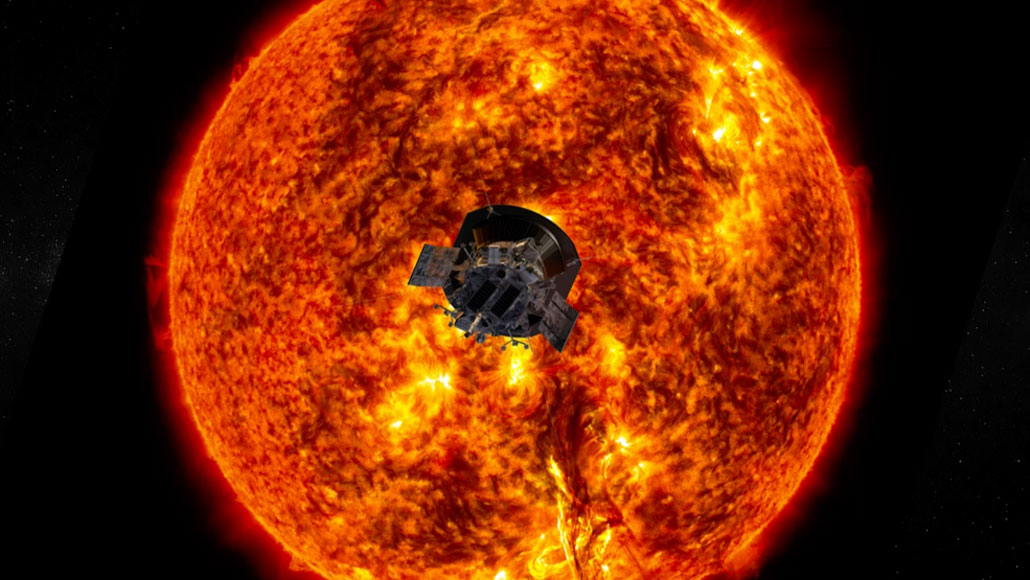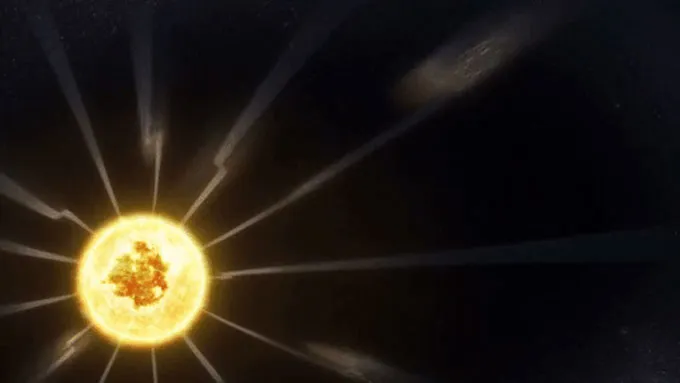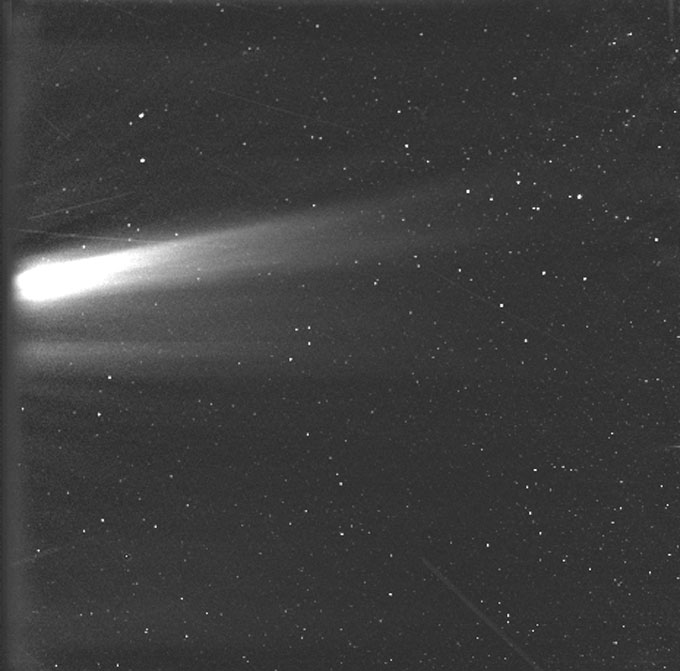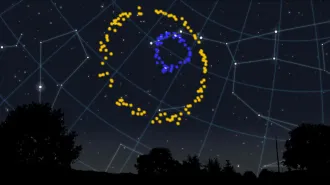
NASA’s Parker Solar Probe (illustrated) has flown closer to the sun than any previous spacecraft and has sent back its first reports from the solar frontier.
Johns Hopkins APL, NASA
Rogue plasma waves. Floating magnetic islands. Showers of charged particles. These are just some of the things NASA’s Parker Solar Probe witnessed during its first two intimate encounters with the sun.
Parker is on a nearly seven-year mission to repeatedly soar near the sun and gather intel on mysteries that have plagued solar physicists for decades (SN: 7/5/18). By flying a robotic craft through the tenuous plasma emanating from the sun, researchers hope to figure out such puzzlers as why the sun’s atmosphere is millions of degrees Celsius hotter than its surface and what powers the solar wind, the stream of charged particles that blows outward through the solar system.
Mission scientists aren’t ready to answer those questions yet. But data from the probe’s first two orbits, published online December 4 in four papers in Nature, offer a sneak peek at what’s to come as Parker moves closer to the sun over the next several years.
“We’re exploring a brand-new region,” says Russell Howard, a solar physicist at the U.S. Naval Research Laboratory in Washington, D.C., who is in charge of the probe’s cameras. “Questions we would have formulated a year ago are just going to be blown away by the things that we’re actually seeing.”
Launched in 2018, Parker is currently on an elliptical orbit that brings it near the sun about every five months (SN: 8/12/18). With its latest close encounter September 1, the probe has now completed three of those trips. Each time, the spacecraft flew within about 24 million kilometers of the sun’s surface — about twice as close as the planet Mercury ever gets.
Parker is already serving up plenty of surprises from its first two trips. For example, “we’ve discovered some unexpected intense rogue [plasma] waves rattling through the sun’s atmosphere,” says mission scientist Justin Kasper, a physicist at the University of Michigan in Ann Arbor.
Bursts of plasma hurtling into space whacked Parker during its close encounters with the sun, data show. Every so often, the speed of the plasma flowing away from the sun would jump by nearly 500,000 kilometers per hour — nearly doubling in speed — for up to a couple of minutes.

“We’ve never seen anything quite like that,” says Philippa Browning, a solar physicist at the University of Manchester in England who is not involved with the mission.
Each of these plasma waves was also accompanied by a sudden reversal of the magnetic field around the probe. “A compass on the spacecraft would have spun all the way around as a wave went past,” Kasper says. The scientists think that they are seeing S-shaped ripples in the magnetic field, as if something near the surface of the sun grabbed a magnetic field line and snapped it like a whip.
Those S-shapes aren’t too surprising to Yannis Zouganelis, an astrophysicist at the European Space Astronomy Centre in Madrid who is not involved with this mission. “We should expect to see bended lines everywhere,” he says. The sun’s magnetic field gets wibbly-wobbly at times, jiggling in response to fluid churning within the sun. “However what is surprising is that we see them very frequently and very strong.”
While the origin of these rogue waves is unclear, the spacecraft recorded about 800 of them over 11 days during the first encounter alone. “That’s a very concrete thing we can try to connect to,” Kasper says. “What is the sun giving off 800 times in 11 days?”

The plasma at Parker’s distance of about 24 million kilometers above the solar surface also whips around the sun much faster than expected. Researchers expected to clock lateral speeds of a few kilometers per second as the escaping plasma gets twirled off into space by the sun’s rotation. Instead, the spacecraft recorded speeds as high as 50 kilometers per second. “That’s really wild,” Kasper says.
Such high speeds might mean that researchers have to rethink how the sun — and all stars — evolve. As stellar winds spiral away, they carry with them rotational energy from the star, gradually putting the brakes on its rotation (SN: 8/2/19). A faster wind spiral might mean stars spin down much faster than thought, Kasper says.
“This is really amazing, if true,” says Zouganelis, though he cautions that before rewriting stellar physics textbooks, these measurements need to be confirmed at lower altitudes. That is one of the many things that Parker will watch for on future orbits, Kasper says.
While Parker was busy raising new questions, it also may have helped solve one mystery: the origin of the “slow” solar wind. The flood of particles from the sun is a blend of two flows, one moving as much as twice as fast as the other. Researchers already knew that the fast component originates near the sun’s poles through funnellike openings in the magnetic field known as coronal holes. Now, Parker’s data suggest that the slow wind flows from small coronal holes near the sun’s equator.
“It hasn’t always been clear that coronal holes can generate the slow wind,” says mission scientist Stuart Bale, a solar physicist at the University of California, Berkeley. “But now we can see this very clearly.”
The list of new tidbits goes on. Parker’s cameras caught the formation of magnetic “islands,” long-predicted tubes of plasma ensnared by a nest of magnetic fields carting energy and matter into space. And the researchers think that they may also be seeing hints of a long-hypothesized but never-before-seen clearing in interplanetary dust near the sun.
The spacecraft also recorded a number of small bursts of energetic particles, mostly protons, coming from the sun. These might provide the seeds for more voluminous particle tsunamis sometimes carried aloft as part of the solar wind, says David McComas, a solar physicist at Princeton University in charge of one of Parker’s particle detectors. These smaller bursts were not seen by other spacecraft orbiting farther out, which means Parker is getting an up-close look at particle acceleration that would otherwise be missed.
“We know that energetic particles come from the sun, but we seem to be seeing many more near the sun,” Browning says. “That tells us that particle acceleration might be much more common than perhaps we thought.”
That fire hose of information from Parker’s initial orbits is sure to keep researchers occupied for years to come. “They’ve created more questions than they answered,” Zouganelis says. “Most of all, these papers show that the instruments work really well, and we’ll have great measurements as they go closer to the sun.”
Parker’s job is far from over. On each of its next 18 orbits, the spacecraft will use the gravity of Venus to inch a little closer to the sun. Then its last three orbits, starting in December 2024, will bring Parker within just 6 million kilometers of the sun’s surface, more than seven times as close as any previous mission, putting all of Parker’s special protective technology to the test (SN: 7/31/18).
Mission lead Nour Raouafi of the Johns Hopkins University Applied Physics Laboratory in Laurel, Md., is confident in the solar probe’s future. “We’ll never see the solar wind the same way,” he says. “Parker is going to rewrite the textbooks for us.”







